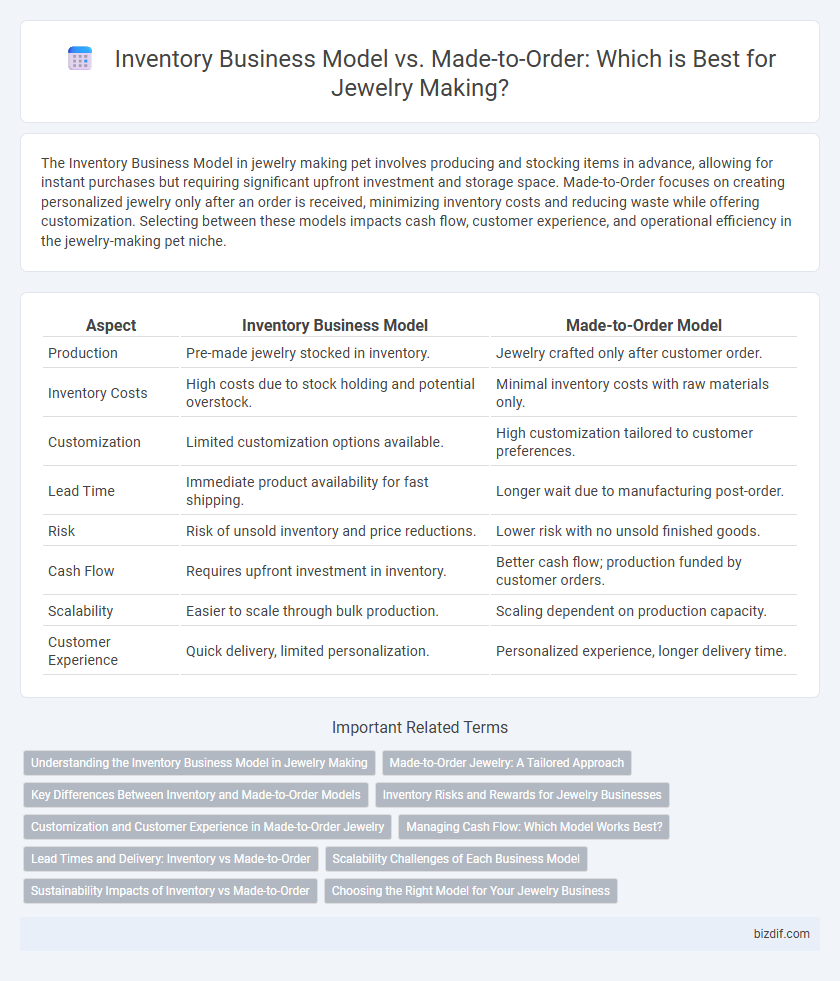The Inventory Business Model in jewelry making pet involves producing and stocking items in advance, allowing for instant purchases but requiring significant upfront investment and storage space. Made-to-Order focuses on creating personalized jewelry only after an order is received, minimizing inventory costs and reducing waste while offering customization. Selecting between these models impacts cash flow, customer experience, and operational efficiency in the jewelry-making pet niche.
Table of Comparison
| Aspect | Inventory Business Model | Made-to-Order Model |
|---|---|---|
| Production | Pre-made jewelry stocked in inventory. | Jewelry crafted only after customer order. |
| Inventory Costs | High costs due to stock holding and potential overstock. | Minimal inventory costs with raw materials only. |
| Customization | Limited customization options available. | High customization tailored to customer preferences. |
| Lead Time | Immediate product availability for fast shipping. | Longer wait due to manufacturing post-order. |
| Risk | Risk of unsold inventory and price reductions. | Lower risk with no unsold finished goods. |
| Cash Flow | Requires upfront investment in inventory. | Better cash flow; production funded by customer orders. |
| Scalability | Easier to scale through bulk production. | Scaling dependent on production capacity. |
| Customer Experience | Quick delivery, limited personalization. | Personalized experience, longer delivery time. |
Understanding the Inventory Business Model in Jewelry Making
The inventory business model in jewelry making involves producing and stocking a wide range of designs upfront, enabling immediate purchase and quick delivery for customers. This model requires accurate demand forecasting and effective inventory management to minimize overstock and reduce holding costs. Retailers benefit from increased sales volume and brand presence but face risks related to unsold inventory and changing fashion trends.
Made-to-Order Jewelry: A Tailored Approach
Made-to-order jewelry offers a tailored approach where each piece is crafted specifically for the customer, minimizing inventory costs and reducing waste. This business model enhances customer personalization, allowing artisans to create unique, custom designs that reflect individual style and preferences. By focusing on made-to-order production, jewelers can maintain high-quality standards while responding flexibly to market trends and consumer demand.
Key Differences Between Inventory and Made-to-Order Models
The inventory business model in jewelry making involves producing and storing finished pieces before customer purchase, ensuring immediate availability and consistent stock levels. Made-to-order models create jewelry only after a customer places an order, allowing for personalized designs and minimizing excess inventory costs. Key differences include production timing, customization flexibility, and inventory risk, with inventory models emphasizing scale and speed, while made-to-order prioritizes uniqueness and demand-driven manufacturing.
Inventory Risks and Rewards for Jewelry Businesses
Inventory business models in jewelry involve holding stock, which can lead to risks such as high carrying costs, potential obsolescence, and tied-up capital, impacting cash flow. However, maintaining an inventory allows for immediate fulfillment, catering to spontaneous customer demand and higher sales volume. Made-to-order reduces inventory risks by producing pieces only after purchase, but it may lengthen delivery times and limit impulse buying opportunities.
Customization and Customer Experience in Made-to-Order Jewelry
Made-to-order jewelry offers unparalleled customization by allowing customers to select materials, designs, and personal engravings, resulting in unique, meaningful pieces. This model enhances customer experience through direct collaboration with artisans, ensuring each item reflects individual style and preferences. Unlike the inventory business model, made-to-order reduces overstock risks and fosters deeper client engagement, driving satisfaction and brand loyalty.
Managing Cash Flow: Which Model Works Best?
Inventory business models in jewelry making require upfront investment in materials and stock, leading to higher initial cash outflows but potentially faster revenue from immediate sales. Made-to-order models minimize inventory costs, improving cash flow by collecting payment before production and reducing the risk of unsold stock. Efficient cash flow management often favors made-to-order, especially for custom or high-value pieces, while inventory models suit businesses with high volume and consistent demand.
Lead Times and Delivery: Inventory vs Made-to-Order
Inventory jewelry business model offers shorter lead times and faster delivery since products are pre-made and stocked, enabling immediate shipping upon purchase. Made-to-order jewelry requires longer lead times as each piece is crafted after receiving the order, often ranging from several days to weeks depending on customization complexity. Efficient inventory management reduces delays, while made-to-order emphasizes personalized craftsmanship at the expense of extended delivery times.
Scalability Challenges of Each Business Model
Inventory business models in jewelry making face scalability challenges due to high upfront costs and risks of unsold stock, requiring significant capital investment and storage space. Made-to-order models limit inventory expenses and reduce waste but struggle with slower production times and difficulty managing increasing order volumes. Both models demand careful resource allocation and operational adjustments to effectively scale production while maintaining quality and customer satisfaction.
Sustainability Impacts of Inventory vs Made-to-Order
Inventory business models in jewelry making often lead to overproduction and excess waste, contributing to significant environmental degradation due to unused materials and unsold stock. Made-to-order practices minimize resource consumption and reduce carbon footprints by producing pieces only when demand exists, promoting sustainable use of precious metals and gemstones. This approach supports circular economy principles by limiting inventory surplus and encouraging responsible sourcing and manufacturing processes.
Choosing the Right Model for Your Jewelry Business
Selecting the right business model for your jewelry enterprise hinges on customer demand, production capacity, and cash flow management. An inventory business model enables immediate sales with pre-made pieces, ideal for high-demand designs and faster turnover, while made-to-order emphasizes customization and reduced waste, catering to niche markets with unique preferences. Evaluating factors like storage costs, lead times, and market trends will determine whether stock-based or bespoke production aligns best with your jewelry brand's growth and profitability goals.
Inventory Business Model vs Made-to-Order Infographic

 bizdif.com
bizdif.com